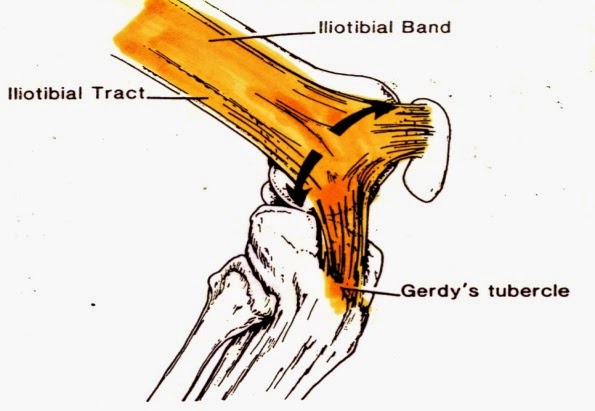Iliotibial Band (IT band) Syndrome
Most people think of Iliotibial Band (IT band) Syndrome as affecting the knee but it can also cause problems at its origin – the hip. The iliotibial band is a superficial thickening of tissue on the outside of the thigh, extending from outside the pelvis, over the hip and inserting just below the knee. The band is crucial to stabilizing the knee during running. As you can imagine the continual rubbing of the band over bone can cause some pain and irritation at the hip.
Signs & Symptoms
- “Stinging sensation” just above the knee joint on the outside of the knee and/or along the entire length of the iliotibial band
- Swelling or thickening of the tissue at the point where the band moves over the femur
- Pain tends to worsen when you overstride, run downhill and when the foot strikes the ground.
Causes
- Anatomical variances such as genu varum (bow legs), excessive pronation of the feet, leg length discrepancy or abnormal tightness of the ITB itself
- Running on a banked/uneven surface, such as the shoulder of the road or an indoor track
- Inadequate warm-up or cool-down
- Running excessive distances or increasing mileage too quickly
Short term treatment for IT band syndrome will involve:
- Decreasing weekly mileage
- Icing of the knee & hip after activity
- Stretching of the iliotibial band
For long term treatment have Dr.Rodwin evaluate your biomechanical alignment- she can treat the muscle injury, as well as any joint restrictions which have occurred to the back, hip, knee or foot. The active release (ART) and trigger point therapy are very effective for IT band problems. It is also beneficial to have your chiropractor evaluate your gait/feet to see if a custom orthotic is required. Massage therapy performed by our registered massage therapists can help to release imbalanced and tight muscles.
Trigger points are taut bands of muscle usually felt as a palpable nodule. Some causes of trigger points include muscle overload and repetitive strain.
Repetitive stress injuries are often the result of computer and assembly line work or the result of repetitive motions related to sports such as running.
With repetitive strain injuries the overall goal is pain management and restoration of joint mobility. Massage, acupuncture, chiropractic and ART can help to achieve these goals.
Chiropractic treatment addresses all the possible causes of RSI’s. The key is determining where the problem originates. Chiropractic adjustments restore proper motion in the joints and the spine.
Acupuncture speeds up the healing process and decreases inflammation by stimulating the natural release of endorphins.
Massage therapy relieves pressure on the nerves by stretching the tissue responsible and helps reduce scar tissue.


